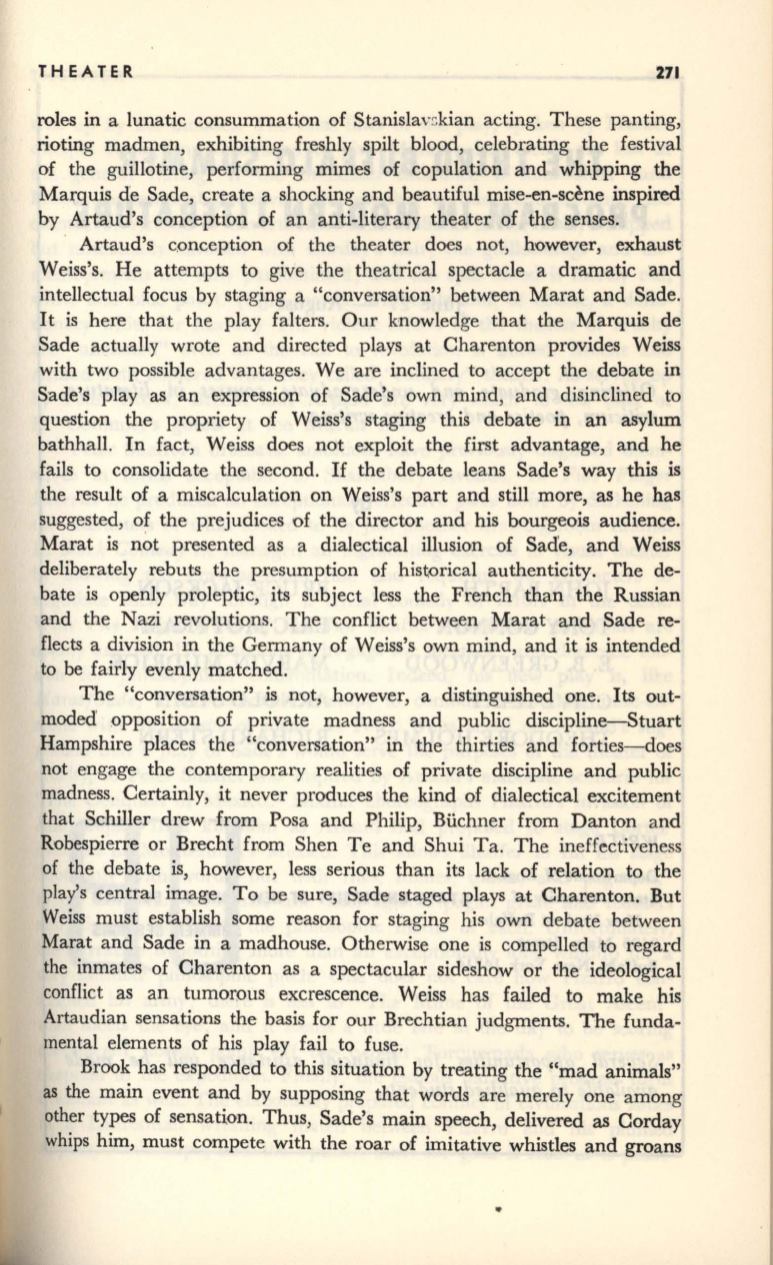
THEATER
271
roles in a lunatic consummation of
Stanislav~kian
acting. These panting,
rioting madmen, exhibiting freshly spilt blood, celebrating the festival
of the guillotine, performing mimes of copulation and whipping the
Marquis de Sade, create a shocking and beautiful mise-en-scene inspired
by Artaud's conception of an anti-literary theater of the senses.
Artaud's cpnception of the theater does not, however, exhaust
Weiss's. He attempts to give the theatrical spectacle a dramatic and
intellectual focus by staging a "conversation" between Marat and Sade.
It is here that the play falters. Our knowledge that the Marquis de
Sade actually wrote and directed plays at Charenton provides Weiss
with two possible advantages. We are inclined to accept the debate in
Sade's play as an expression of Sade's own mind, and disinclined to
question the propriety of Weiss's staging this debate in an asylum
bathhall. In fact, Weiss does not exploit the first advantage, and he
fails to consolidate the second.
If
the debate leans Sade's way this is
the result of a miscalculation on Weiss's part and still more, as he has
suggested, of the prejudices of the director and his bourgeois audience.
Marat is not presented as a dialectical illusion of Sade, and Weiss
deliberately rebuts the presumption of historical authenticity. The de–
bate is openly proleptic, its subject less the French than the Russian
and the Nazi revolutions. The conflict between Marat and Sade re–
flects a division in the Germany of Weiss's own mind, and it is intended
to be fairly evenly matched.
The "conversation" is not, however, a distinguished one. Its out–
moded opposition of private madness and public discipline-Stuart
Hampshire places the "conversation" in the thirties and forties-does
not engage the contemporary realities of private discipline and public
madness. Certainly, it never produces the kind of dialectical excitement
that Schiller drew from Posa and Philip, Buchner from Danton and
Robespierre or Brecht from Shen Te and Shui Ta. The ineffectiveness
of the debate is, however, less serious than its lack of relation to the
play's central image. To be sure, Sade staged plays at Charenton. But
Weiss must establish some reason for staging his own debate between
Marat and Sade in a madhouse. Otherwise one is compelled to regard
the inmates of Charenton as a spectacular sideshow or the ideological
conflict as an tumorous excrescence. Weiss has failed to make his
Artaudian sensations the basis for our Brechtian judgments. The funda–
mental elements of his play fail to fuse.
Brook has responded to this situation by treating the "mad animals"
as
the main event and by supposing that words are merely one among
other
types
of sensation. Thus, Sade's main speech, delivered as Corday
whips him, must compete with the roar of imitative whistles and groans


